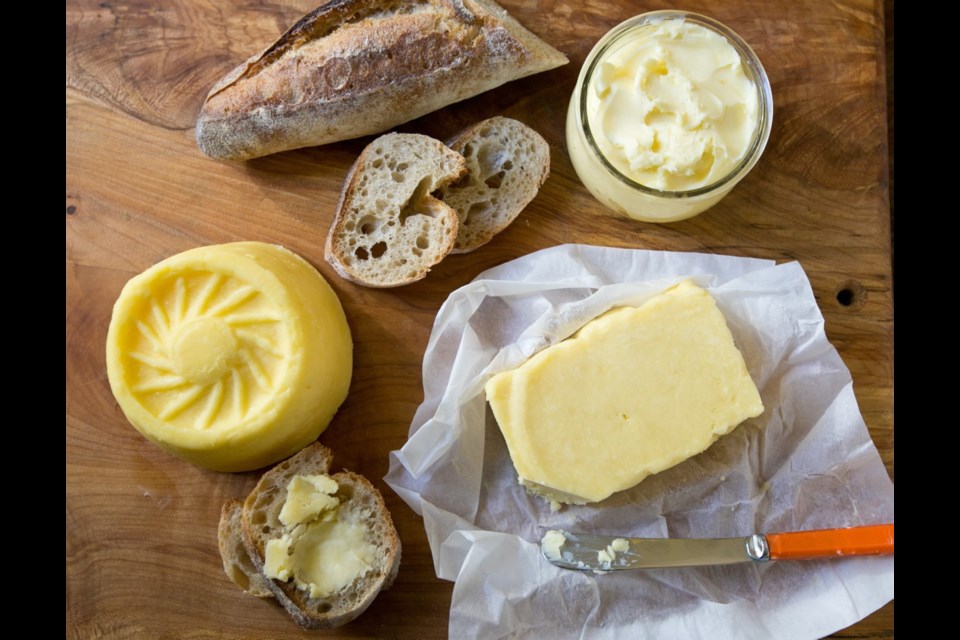 Dear Eric: I read your recent article about butter with interest. That in turn caused me to send a note asking if you know where one can buy quality-tasting butter. I have found on cruise ships and a recent trip to France that the butter seems to taste better than what we can buy here. A bit of online research revealed that the production of butter in Canada seems to be tightly regulated to support 91ԭ�� producers, and I wondered if that is limiting the butter available locally.
Dear Eric: I read your recent article about butter with interest. That in turn caused me to send a note asking if you know where one can buy quality-tasting butter. I have found on cruise ships and a recent trip to France that the butter seems to taste better than what we can buy here. A bit of online research revealed that the production of butter in Canada seems to be tightly regulated to support 91ԭ�� producers, and I wondered if that is limiting the butter available locally.
Brian
The article on butter that Brian is referring to was published two weeks ago. It described the difference between salted and unsalted butter and how to use them in
baking. If you missed it, go to timescolonist.com and search unsalted butter.
Brian is correct when he says the 91ԭ�� dairy industry is tightly regulated. Also, in places such as France, you do see a wider array of butter, but that is changing in Canada, especially in places such as Quebec.
That said, I don’t think those are the reasons Brian has been unable to find butter with the flavour traits he enjoyed outside Canada.
I believe he has just been shopping in the wrong places and/or he has been buying the wrong style of
butter.
With regard to the latter, on the Dairy Farmers of Canada website, dairygoodness.ca, you’ll find descriptions of the styles of butter sold in Canada and elsewhere.
The most common type sold in foil-wrapped blocks in every supermarket is churned butter, but you would not know that because most often it’s simply labelled butter.
The Dairy Farmers of Canada say churned butter is traditional butter made by churning pasteurized cream. 91ԭ�� regulations say it must contain at least 80 per cent fat, about 16 per cent water and about three per cent milk solids. Churned butter is available in salted, reduced salt and unsalted versions.
Churned butter is also made with organic cream, which, to my taste buds, when trying it from companies such as B.C.-based Avalon Dairy, seems to have a richer taste than butter made with non-organic cream.
Another style of butter, and the type I believe Brian enjoyed in France and on that cruise ship, is called cultured butter, which is common in Europe and becoming more widely available in Canada.
The Dairy Farmers of Canada says cultured butter is made from cream that is cultured with active bacteria (similar to yogurt) and has a distinctive, slightly tangy taste.
Cultured butter, not surprisingly, is also known as European-style butter. You may also see it labelled old-fashioned, ancestral or antique butter. The latter makes sense because in the days before refrigeration, the cream might have soured a bit before being churned into butter.
Although 91ԭ�� churned butter is of high quality, most don’t have that more complex taste that Brian and others find appealing in cultured butter. I was able to find cultured butter at several locations in Victoria.
At large supermarkets, the cultured butter most often sold came from a large company, such as Lactantia, which sells a product called “Swiss Flavour” cultured butter, and Dairyland, which sells a product called European-style butter.
In a smaller grocery store and a specialty food store in Victoria, I was able to find cultured butter from smaller producers, who might not make enough product to stock a supermarket chain.
For example, at Ottavio Italian Bakery & Delicatessen, 2272 Oak Bay Ave., I saw ancestral butter made by Fromagerie Le Détour. At Pepper’s Grocery, 3829 Cadboro Bay Rd., they had Riviera petit pot cultured butter. Both butters are from Quebec and taste wonderful.
Beyond cultured butter, another interesting style of butter made in Quebec is whey butter, which I saw at Ottavio’s. It is made from whey separated from curd during cheese-making. It’s bold tasting with a hint of cheese in its flavour and is saltier-tasting than other butters.
At Choux Choux Charcuterie, 830 Fort St., another type was sea-salted creamery butter made by Cow’s Creamery in Prince Edward Island. That company describes it as a premium butter containing 84 per cent butter fat, made by churning the cream slower and longer that in traditional churns. Cow’s Creamery says this creates butter with a creamier taste and silkier texture, and I agree with them.
Cultured butter, organic butter and the other specialty butter noted above cost more than regular, salted butter — sometimes double or triple the price.
Because of the cost, I’m not sure I would use specialty butter, cultured in particular, for baking, because its flavour might be lost. Instead, I would save it for situations where you get to fully enjoy its fine flavour, such as simply slathering it on baguette.
Eric Akis is the author of The Great Rotisserie Chicken Cookbook (Appetite by Random House). His columns appear in the Life section Wednesday and Sunday.



